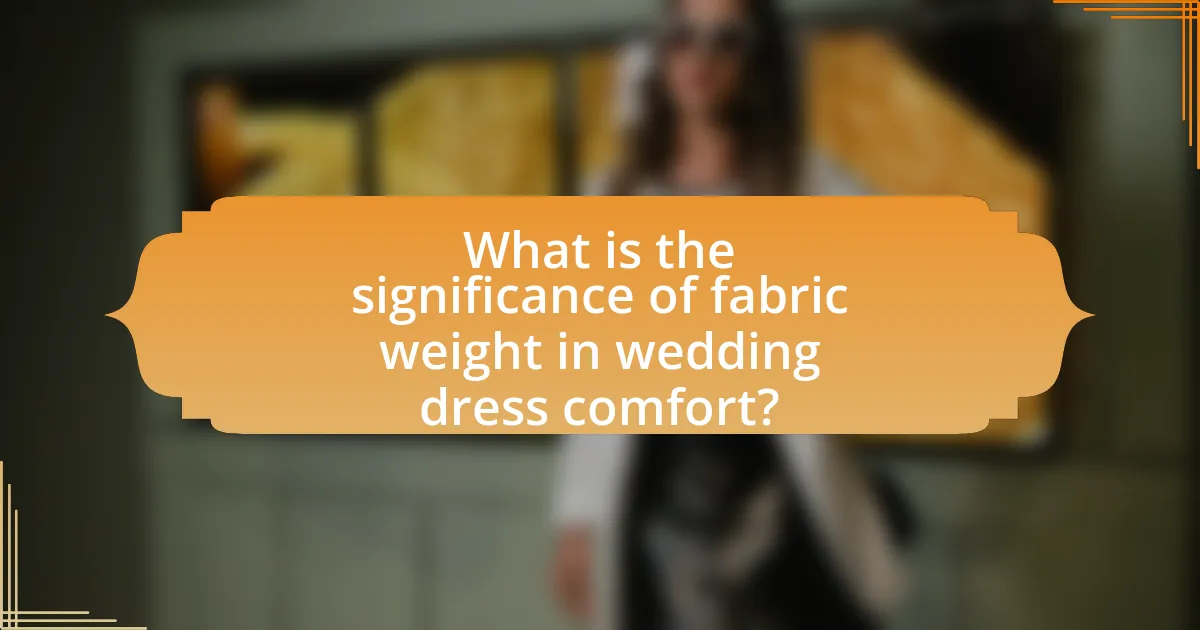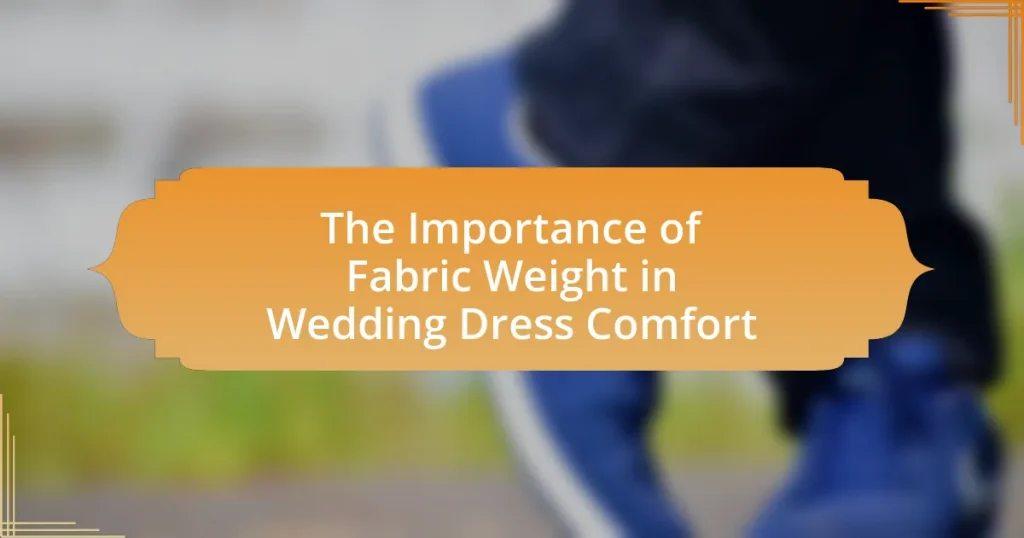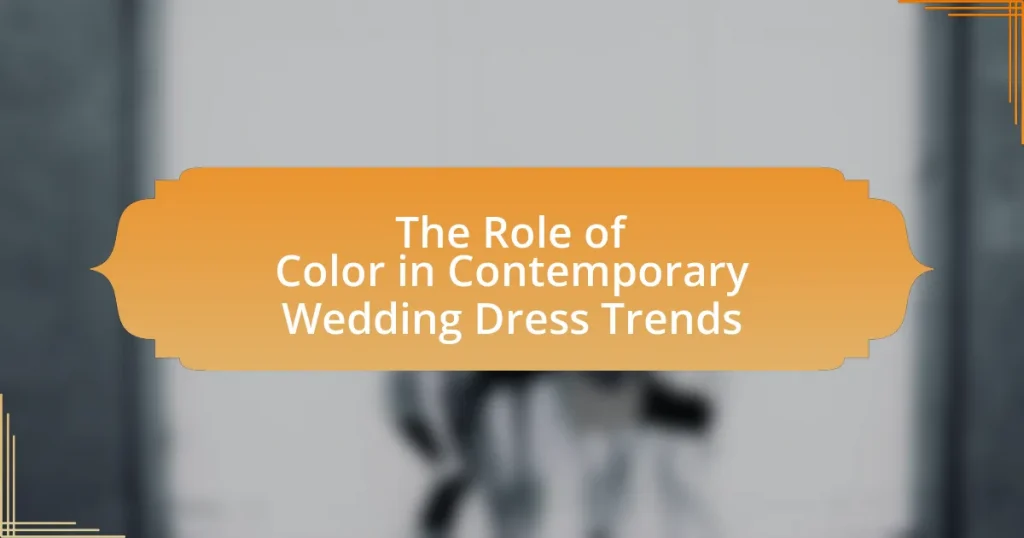The article focuses on the significance of fabric weight in ensuring comfort for wedding dresses. It explains how fabric weight affects breathability, drape, and ease of movement, highlighting the differences between lightweight fabrics like chiffon and heavier materials such as satin. The discussion includes the impact of fabric weight on temperature regulation, fit, and silhouette, as well as practical considerations for brides when selecting their wedding dress. Additionally, it addresses common misconceptions about fabric weight and provides advice on how to choose the appropriate fabric based on climate, personal style, and comfort needs.

What is the significance of fabric weight in wedding dress comfort?
Fabric weight significantly impacts wedding dress comfort by influencing breathability, drape, and overall wearability. Lighter fabrics, such as chiffon or tulle, allow for better airflow and ease of movement, making them ideal for warm weather or outdoor ceremonies. Conversely, heavier fabrics like satin or brocade provide structure and support but can lead to discomfort in hot conditions. Studies indicate that the right fabric weight can enhance the wearer’s experience, as comfort directly correlates with the ability to move freely and maintain a pleasant body temperature throughout the event.
How does fabric weight influence the overall comfort of a wedding dress?
Fabric weight significantly influences the overall comfort of a wedding dress by affecting its drape, breathability, and ease of movement. Lighter fabrics, such as chiffon or organza, provide a more breathable and comfortable experience, especially in warm weather, allowing for better airflow and reduced heat retention. Conversely, heavier fabrics like satin or taffeta can create a structured silhouette but may restrict movement and cause discomfort over extended wear. Studies indicate that the choice of fabric weight can impact the wearer’s comfort level, with lighter materials often preferred for their softness and flexibility, enhancing the overall wearing experience during a long event like a wedding.
What are the different fabric weights commonly used in wedding dresses?
The different fabric weights commonly used in wedding dresses include lightweight, medium weight, and heavy weight fabrics. Lightweight fabrics, such as chiffon and organza, are often chosen for their airy feel and flow, making them ideal for summer weddings. Medium weight fabrics, like satin and taffeta, provide structure and elegance, suitable for various wedding styles. Heavy weight fabrics, such as brocade and velvet, offer a luxurious look and are typically used in formal or winter weddings. Each fabric weight contributes to the overall comfort and aesthetic of the wedding dress, ensuring it meets the bride’s vision and the event’s requirements.
How does fabric weight affect breathability and temperature regulation?
Fabric weight significantly influences breathability and temperature regulation, with lighter fabrics generally offering better airflow and moisture management. For instance, lightweight materials like chiffon and organza allow air to circulate more freely, enhancing comfort in warm conditions, while heavier fabrics like satin can trap heat and moisture, leading to discomfort. Studies indicate that fabrics with lower weight often have higher porosity, which facilitates evaporation and cooling, making them preferable for warm-weather attire, such as wedding dresses.
Why is understanding fabric weight crucial for brides?
Understanding fabric weight is crucial for brides because it directly impacts the comfort, drape, and overall fit of the wedding dress. Lighter fabrics, such as chiffon or tulle, provide breathability and ease of movement, making them ideal for warm weather or outdoor ceremonies. Conversely, heavier fabrics like satin or brocade offer structure and elegance but can be less comfortable in hot conditions. Research indicates that the choice of fabric weight can affect how a bride feels throughout the day, influencing her confidence and enjoyment during the event. Therefore, selecting the appropriate fabric weight is essential for ensuring that the bride remains comfortable and looks her best on her wedding day.
What role does fabric weight play in the dress’s fit and silhouette?
Fabric weight significantly influences a dress’s fit and silhouette by determining how the material drapes and conforms to the body. Heavier fabrics, such as satin or brocade, provide structure and shape, allowing for tailored silhouettes that maintain their form, while lighter fabrics, like chiffon or tulle, create a more flowing and ethereal appearance, often resulting in softer lines. The choice of fabric weight directly affects the overall aesthetic and comfort of the dress, as heavier materials can restrict movement, whereas lighter options enhance breathability and ease of wear.
How can fabric weight impact the ease of movement for the bride?
Fabric weight significantly impacts the ease of movement for the bride by influencing how the dress drapes and flows. Lighter fabrics, such as chiffon or tulle, allow for greater mobility and comfort, enabling the bride to move freely during the ceremony and reception. In contrast, heavier fabrics like satin or brocade can restrict movement, making it more challenging to walk, dance, or sit comfortably. Studies in textile science indicate that lighter materials reduce fatigue and enhance overall comfort, which is crucial for a long event like a wedding.

What factors should be considered when choosing fabric weight for a wedding dress?
When choosing fabric weight for a wedding dress, factors such as climate, dress style, and comfort should be considered. The climate influences the fabric weight; lighter fabrics like chiffon are suitable for warm weather, while heavier fabrics like satin provide warmth in cooler conditions. The dress style also dictates fabric weight; structured designs may require heavier fabrics for support, while flowing styles benefit from lighter materials. Comfort is paramount, as the bride will wear the dress for an extended period; thus, selecting a fabric weight that allows for ease of movement and breathability is essential.
How do climate and season affect fabric weight selection?
Climate and season significantly influence fabric weight selection for wedding dresses. In warmer climates or during summer months, lighter fabrics such as chiffon or organza are preferred to ensure breathability and comfort, as these materials allow for better air circulation and reduce heat retention. Conversely, in cooler climates or during winter, heavier fabrics like satin or velvet are chosen for their insulation properties, providing warmth and a more structured silhouette. This selection process is supported by the fact that fabric weight directly impacts the overall comfort and wearability of the dress, as lighter fabrics can prevent overheating while heavier fabrics can enhance warmth and elegance in colder conditions.
What are the best fabric weights for summer weddings?
The best fabric weights for summer weddings are lightweight materials, typically ranging from 2 to 6 ounces per square yard. Fabrics such as chiffon, georgette, and lightweight cotton are ideal because they allow for breathability and comfort in warm weather. These materials help to prevent overheating, which is crucial for outdoor ceremonies or receptions during the summer months. Additionally, lightweight fabrics drape elegantly, enhancing the overall aesthetic of wedding attire while ensuring the wearer remains cool and comfortable.
Which fabric weights are ideal for winter weddings?
Fabric weights between 8 to 12 ounces per square yard are ideal for winter weddings. Heavier fabrics such as velvet, brocade, and thick satin provide warmth and structure, making them suitable for colder temperatures. These fabric weights ensure that the wedding dress not only looks elegant but also offers comfort against winter chills, as they retain heat better than lighter materials.
What personal preferences should brides keep in mind regarding fabric weight?
Brides should consider their comfort and the climate when selecting fabric weight for their wedding dress. Lighter fabrics, such as chiffon or organza, are ideal for warm weather, providing breathability and ease of movement. Conversely, heavier fabrics like satin or taffeta offer structure and warmth, making them suitable for cooler climates. Additionally, personal preferences regarding the dress’s silhouette and style can influence fabric choice; for example, a fitted gown may benefit from a heavier fabric for support, while a flowing design may be enhanced by lighter materials.
How does personal style influence the choice of fabric weight?
Personal style significantly influences the choice of fabric weight by dictating the desired aesthetic and comfort level of the garment. For instance, individuals who prefer a more structured look may opt for heavier fabrics like satin or taffeta, which provide shape and formality, while those favoring a relaxed, bohemian style might choose lighter fabrics such as chiffon or lace for their flowy and airy qualities. This correlation is supported by the fact that fabric weight affects not only the visual appeal but also the drape and movement of the dress, which are crucial for achieving the intended style.
What comfort features should brides prioritize when selecting fabric weight?
Brides should prioritize breathability and drape when selecting fabric weight for their wedding dress. Breathability ensures comfort throughout the day, especially in varying temperatures, while drape affects how the fabric falls and moves with the body. Lightweight fabrics like chiffon or organza offer excellent breathability, making them suitable for warmer climates, whereas heavier fabrics like satin provide structure but may retain heat. Studies indicate that fabrics with a weight of 3-5 ounces per square yard are optimal for comfort, balancing structure and airflow, thus enhancing the overall wearing experience.

How can brides ensure they choose the right fabric weight for their wedding dress?
Brides can ensure they choose the right fabric weight for their wedding dress by considering the season, venue, and desired comfort level. For instance, lightweight fabrics like chiffon or organza are ideal for summer weddings, while heavier materials such as satin or taffeta provide warmth for winter ceremonies. Additionally, brides should assess how the fabric drapes and feels against their skin, as this directly impacts comfort during the event. Research indicates that fabric weight significantly influences the overall wearability of garments, with lighter fabrics often being more breathable and suitable for warmer climates.
What tips can help brides assess fabric weight during fittings?
Brides can assess fabric weight during fittings by feeling the fabric in their hands and observing how it drapes on their body. A heavier fabric typically provides more structure and support, while lighter fabrics offer a flowy and airy feel. Additionally, brides should consider the fabric’s response to movement; for instance, fabrics like silk may feel luxurious but can be less forgiving in terms of weight distribution. Testing the fabric’s weight against the body by lifting and moving can also help in understanding comfort levels. This approach is validated by the fact that fabric weight significantly influences the overall comfort and fit of a wedding dress, impacting how it feels throughout the day.
How can brides test the comfort of different fabric weights?
Brides can test the comfort of different fabric weights by trying on dresses made from various materials and paying attention to how each fabric feels against their skin. This hands-on approach allows brides to assess factors such as breathability, flexibility, and overall comfort during movement. Additionally, brides should consider the climate and venue of their wedding, as heavier fabrics may be less comfortable in warm settings, while lighter fabrics may not provide enough warmth in cooler environments. Testing multiple fabric weights in different styles can help brides make an informed decision about their wedding dress comfort.
What questions should brides ask their designers about fabric weight?
Brides should ask their designers about the specific weight of the fabric being used in their wedding dress. Understanding the fabric weight is crucial because it directly affects the dress’s comfort, drape, and suitability for different weather conditions. Additionally, brides should inquire how the fabric weight influences the overall silhouette and movement of the dress, as heavier fabrics may provide structure while lighter fabrics offer flow. It is also important to ask about the fabric’s breathability and how it will feel against the skin, especially for long wear during the wedding day.
What are common misconceptions about fabric weight in wedding dresses?
Common misconceptions about fabric weight in wedding dresses include the belief that heavier fabrics are always more luxurious and that lighter fabrics lack structure. In reality, fabric weight does not solely determine the quality or elegance of a wedding dress; many lightweight fabrics, such as chiffon and tulle, can provide a beautiful drape and movement while still appearing sophisticated. Additionally, some brides assume that heavier fabrics will be more durable, but this is not always the case, as the longevity of a dress also depends on the type of fabric and its care. Understanding these misconceptions helps brides make informed choices that prioritize comfort and style.
Why do some brides underestimate the importance of fabric weight?
Some brides underestimate the importance of fabric weight because they prioritize aesthetics over functionality. This oversight can lead to discomfort, as lighter fabrics may not provide the necessary structure or support, resulting in issues like transparency or inadequate coverage. Additionally, many brides may lack knowledge about how fabric weight affects breathability and draping, which are crucial for comfort during long wedding events. Studies indicate that heavier fabrics, such as satin or taffeta, offer better support and shape retention, enhancing overall comfort and appearance throughout the day.
How can understanding fabric weight improve the overall wedding experience?
Understanding fabric weight can significantly enhance the overall wedding experience by ensuring comfort and suitability for the wedding environment. Lighter fabrics, such as chiffon or organza, provide breathability and ease of movement, which is crucial for long wedding days, while heavier fabrics like satin or taffeta offer structure and elegance. Choosing the appropriate fabric weight based on the wedding season and venue can prevent discomfort, such as overheating in warm weather or feeling weighed down in a formal setting. Research indicates that comfort directly influences the enjoyment of significant events; for instance, a study published in the Journal of Fashion Technology & Textile Engineering highlights that comfort in clothing enhances overall satisfaction during social occasions. Thus, understanding fabric weight allows couples to select wedding attire that aligns with their comfort needs, ultimately leading to a more enjoyable wedding experience.
What practical advice can brides follow to select the best fabric weight?
Brides should consider the climate and venue when selecting the best fabric weight for their wedding dress. For warmer climates or outdoor weddings, lightweight fabrics like chiffon or organza provide breathability and comfort, while heavier fabrics such as satin or taffeta are suitable for cooler environments or formal settings. Additionally, brides should assess the dress silhouette; structured designs may require heavier fabrics for support, whereas flowing styles benefit from lighter materials. This approach ensures that the chosen fabric weight aligns with both comfort and aesthetic preferences, enhancing the overall wedding experience.



